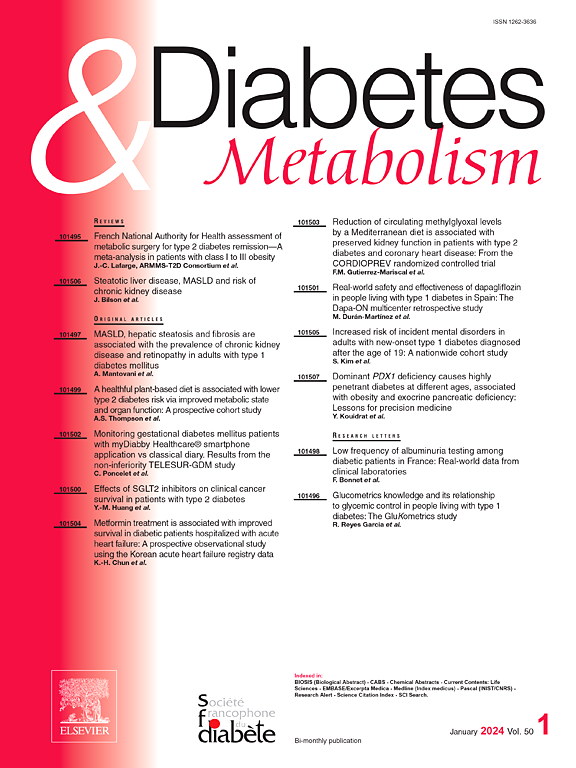SGLT2抑制剂治疗继发于外分泌胰腺疾病的糖尿病患者的心肾结局和安全性:一项基于全国人群的研究
IF 4.7
2区 医学
Q1 ENDOCRINOLOGY & METABOLISM
引用次数: 0
摘要
目的:关于外分泌胰腺(DEP)继发糖尿病的药物治疗有效性的数据有限。本研究评估了钠-葡萄糖共转运蛋白2 (SGLT2)抑制剂在dep患者中的实际有效性和安全性。方法:使用韩国国民健康保险服务数据库的数据进行回顾性队列研究。分析了2014年9月至2022年12月期间66120名开始使用降糖药物(GLDs)的DEP患者的数据。使用倾向评分匹配,启动SGLT2抑制剂的患者与启动其他gld的患者进行1:1匹配。疗效结局包括主要不良心血管事件(mace)、心力衰竭、终末期肾病(ESKD)和全因死亡率。安全性结果包括低血糖、糖尿病酮症酸中毒、生殖器感染、尿路感染、骨折和胰腺炎。结果:匹配后,4128名SGLT2抑制剂-其他GLD用户对被纳入分析,平均随访时间为2.3年。与使用其他GLDs相比,使用SGLT2抑制剂与MACE风险显著降低相关(风险比[HR]: 0.69;95%可信区间[CI]: 0.51-0.93),心力衰竭住院(HR: 0.70;95% ci: 0.51-0.95), eskd (hr: 0.19;95% CI: 0.06-0.61)和全因死亡率(HR: 0.38;95% ci: 0.27-0.53)。使用SGLT2抑制剂与尿路感染风险降低相关(HR: 0.87;95% CI: 0.78-0.96)和胰腺炎(HR 0.71;95% ci 0.58-0.87)。结论:SGLT2抑制剂与不良心肾结局和全因死亡率的降低相关,并且可以安全地用于DEP患者。本文章由计算机程序翻译,如有差异,请以英文原文为准。
Cardiorenal outcomes and safety of SGLT2 inhibitors in patients with diabetes secondary to disorders of the exocrine pancreas: a nationwide population-based study
Aims
Limited data are available on the effectiveness of pharmacological treatments for diabetes secondary to disorders of the exocrine pancreas (DEP). This study evaluated the real-world effectiveness and safety of sodium-glucose cotransporter 2 (SGLT2) inhibitors in individuals with DEP.
Methods
A retrospective cohort study was conducted using data from the Korean National Health Insurance Service database. Data on 66,120 individuals with DEP who initiated glucose-lowering drugs (GLDs) between September 2014 and December 2022 were analyzed. Patients initiating SGLT2 inhibitors were matched 1:1 with patients initiating other GLDs using propensity-score matching. The effectiveness outcomes included major adverse cardiovascular events (MACEs), heart failure, end-stage kidney disease (ESKD), and all-cause mortality. The safety outcomes included hypoglycemia, diabetic ketoacidosis, genital infections, urinary tract infections, fractures, pancreatitis, and pancreatic cancer.
Results
After matching, 4,128 SGLT2 inhibitor-other GLD user pairs were included in the analysis, with a mean follow-up of 2.3 years. Compared with use of other GLDs, use of SGLT2 inhibitors was associated with a significantly lower risk of MACE (hazard ratio [HR]: 0.69; 95% confidence interval [CI]: 0.51–0.93), hospitalization for heart failure (HR: 0.70; 95% CI: 0.51–0.95), ESKD (HR: 0.19; 95% CI: 0.06–0.61), and all-cause mortality (HR: 0.38; 95% CI: 0.27–0.53). SGLT2 inhibitor use was associated with a reduced risk of urinary tract infections (HR: 0.87; 95% CI: 0.78–0.96) and pancreatitis (HR 0.71; 95% CI 0.58–0.87).
Conclusions
SGLT2 inhibitors were associated with a reduced risk of adverse cardiorenal outcomes and all-cause mortality and were safely used in patients with DEP.
求助全文
通过发布文献求助,成功后即可免费获取论文全文。
去求助
来源期刊

Diabetes & metabolism
医学-内分泌学与代谢
CiteScore
12.00
自引率
4.20%
发文量
86
审稿时长
13 days
期刊介绍:
A high quality scientific journal with an international readership
Official publication of the SFD, Diabetes & Metabolism, publishes high-quality papers by leading teams, forming a close link between hospital and research units. Diabetes & Metabolism is published in English language and is indexed in all major databases with its impact factor constantly progressing.
Diabetes & Metabolism contains original articles, short reports and comprehensive reviews.
 求助内容:
求助内容: 应助结果提醒方式:
应助结果提醒方式:


